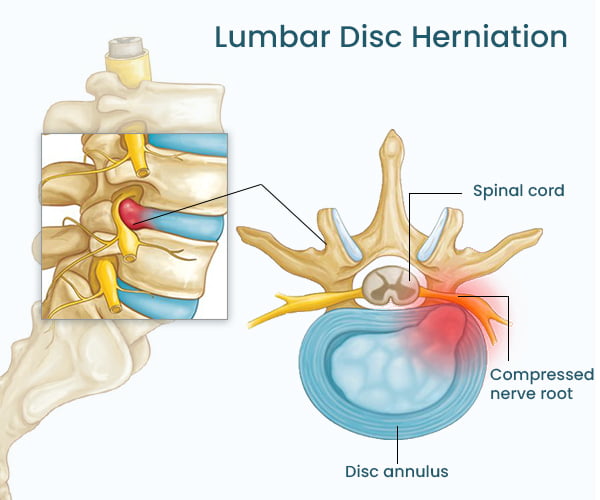Understanding Lumbar Disc Herniation
Understanding Lumbar Disc Herniation
Blog Article

A lumbar disc herniation occurs when/if/as the soft, gel-like center of an intervertebral disc pushes through its tough outer get more info layer. This can happen due to factors such as/causes like/reasons including age, injury, repetitive motions, and genetics. Symptoms often include shooting or numbness in the legs, along with muscle spasms.
Treatment options for lumbar disc herniation vary depending on the severity of symptoms and can involve a combination of conservative measures like rest/physical therapy/over-the-counter pain relievers and, in some cases, surgical intervention.
- Conservative treatments
- {Include rest andactivity modification to reduce stress on the spine
- Involve physical therapy exercises to strengthen back and core muscles
- May encompass over-the-counter pain relievers or prescription medications for inflammation and nerve pain
- Spinal surgery
- {Can be considered when conservative treatments are ineffective to relieve symptoms
- May involve removing a portion of the herniated disc or fusing vertebrae together
- Offers the potential for long-term pain relief and improved function
It is crucial to consult with a healthcare professional for an accurate diagnosis and personalized treatment plan for lumbar disc herniation.
Grasping a Ruptured Disc in Your Lower Back
A ruptured disc, also known as a herniated disc, is a common problem that can trigger lower back pain. It occurs when the soft, jelly-like center of an intervertebral disc pushes through its tough outer layer. This can compress nerves in your spinal cord, leading to pain, numbness, or weakness along your legs. The severity of symptoms varies depending on the position of the rupture and how much of nerve compression.
Some factors can contribute to a ruptured disc, such as age, injury, repetitive stress on your back, and smoking. If you are experiencing lower back pain, it's important to see a doctor to determine the cause and receive appropriate treatment.
Chronic Back Pain Relief: Addressing Lumbar Disc Damage
Chronic back pain is a prevalent ailment that can significantly impact an individual's quality of life. One common cause of chronic back pain is lumbar disc injuries, which occur when the soft, gel-like center of an intervertebral disc bulges or ruptures, putting pressure on surrounding nerves. These afflictions can manifest as sharp, shooting pains, numbness, tingling, or weakness in the lower back, hips, or legs. Thankfully, there are various treatment options available to alleviate chronic back pain caused by lumbar disc injuries.
- Physical therapy plays a crucial role in restoring mobility and strengthening the muscles that support the spine.
- Medications such as nonsteroidal anti-inflammatory drugs (NSAIDs) can help reduce inflammation and pain.
- In some cases, injections of corticosteroids into the affected area may provide temporary relief.
- If conservative treatments prove ineffective, surgery may be recommended to remove or repair the damaged disc.
It's important to consult with a healthcare professional for an accurate diagnosis and personalized treatment plan. Early intervention can often prevent long-term complications and improve outcomes for individuals suffering from chronic back pain due to lumbar disc injuries.
A Herniated Disc : When Everyday Activities Become Agony
Imagine twisting for something simple – like that book on the top shelf. A sudden searing pain shoots through your back. You cry out, clutching your midsection, realizing with a sinking feeling that this isn't just any old muscle strain. This is the agonizing reality of a herniated disc.
A herniated disc occurs when the soft, jelly-like center of a spinal disc bulges through its tough outer layer, putting pressure on nearby nerves. This can cause intense pain that radiates along your sciatic nerve.
- Simple activities
- Like walking
suddenly become excruciatingly painful.
Living with a Lumbar Disc Rupture: Tips for Managing Pain and Function
Living with a lumbar disc rupture can be difficult. It's important to remember that while the pain can be severe, there are proven ways to manage it and improve your daily function.
One of the most essential things you can do is listen to your body. Avoid activities that aggravate your pain and take frequent breaks when engaging in physical movements.
It's also important to maintain a healthy weight, as extra pounds place added stress on your spine. Low-impact exercise, such as walking or swimming, can help strengthen the muscles that support your back and reduce pain.
- See a doctor for proper diagnosis and treatment options.
- Look into physical therapy to learn exercises that strengthen your back.
- Apply heat or ice packs to the affected area for pain relief.
Remember, managing a lumbar disc rupture is a long-term process. Be patient with yourself and aim to incorporate these tips into your daily routine for optimal results.
Influence of Herniated Discs on Daily Life
A herniated disc can significantly disrupt your daily life, often leading to aching. Everyday activities like walking and even simple tasks such as lifting can become incredibly troublesome.
The severity of these issues varies from person to person, but common complaints include:
* Sensation loss in the arms or legs
* Weakness in the limbs
* Shooting pain that intensifies with certain movements
If you're experiencing these symptoms, it's important to consult a doctor. They can help determine the cause of your discomfort and recommend the best course of therapy.
Report this page